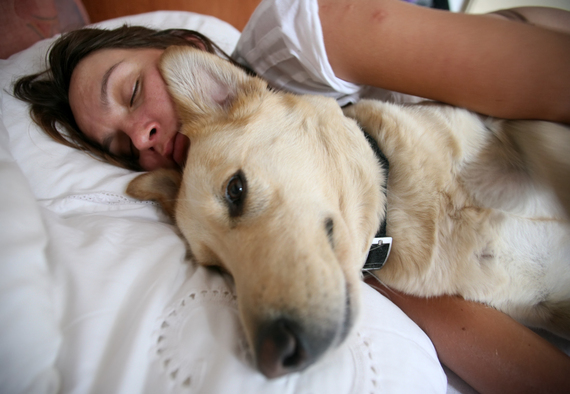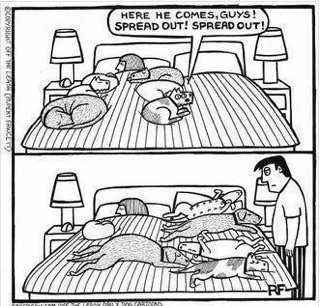Have you ever worried that sleeping with your dog or sharing some cuddle time with your puppy is against all the training rules?
Are you one of the multitudes taught to believe that inviting your otherwise adoring, sweet, innocent dog or puppy onto your lap will turn him into Kujo?
Do you have a family member, convinced by some celebrity trainer, who fills you with guilt each time you pat the bed sheets or lift your baby up for a snuggle?
Do. This. Now! Call your dog or puppy over, lift him gently onto your lap (offering him a bone if he's nippy) and take three deep breaths. Now repeat after me: It's ok to be loving, it's ok to be loving, it's ok to be loving.
All the research and home practices by not only myself but all the top veterinarians and veterinary behaviorists (Drs. Jeff Werber, Nicholas Dodman, Marty Becker, Ian Dunbar) show that snuggling with an otherwise friendly dog or puppy will not cause aggression. As long as you're someone who also offers positive encouragements and routine care, then sitting or sleeping next to your dog or puppy while he rests, won't make him aggressive. You have my permission to do all that.
But yelling at your dog, strapping electronic collars, pinning or poking him, and then expecting him to curl up next to you peacefully might not end so well, though. Just saying.
Still puzzled by what causes some dogs to act out aggressively when resting on the sofa or bed? You're not alone. Aggressive behavior is not uncommon when people and dogs live under the same roof.
In today's blog, I'll offer you some quick tips to improve your dog's attitude while resting in privileged places. Our next blog will focus on leash aggression. I'm also happy to field any questions you may have regarding your dog's aggressive reactions: just add them to the comment section below.
First, let's be clear on what aggression is and what it isn't. Aggression is one way a dog may respond to extreme feelings of fear or frustration. Aggression is not a dog behaving badly.
Kids act out aggressively all the time; grown-ups too. The only startling difference between a child's emotional tornado and dogs is that a dog will show or use their teeth.
Consider what causes dogs and children fear or frustration.
What Kids and Dogs Fear
Being alone
Silence
Unfamiliar noises
Unpredictable people
Strange dogs acting up
What Frustrates Kids and Dogs
Being Locked away
Not getting their way
Unable to reach something
Being restrained
Studies show that dogs and children have nearly identical brain development. The emotional similarities are obvious, yet, while both kids and dogs can be conditioned to positively accept things they cannot change, without the effort they may not be able to cope.
So what does all this have to do with cuddling up with dogs? In short, loads.
When you allow your dog onto a bed or sofa, you're saying let's rest together. It's intimate and loving. If that's how you act with your dog throughout the day, he'll feel equally comfortable being near you.
But, and this is a big but, if you isolate your dog too much, if you're frustrated or react in ways that frighten him through the day, or if you don't, but other family members do, then the whole snuggle-with-me now invitation will confuse your dog.
Dogs who are yelled at, shocked or hit, can't distinguish when you're happy and when you're not. They fear anyone's head-on approach at all times, and even more so when they are elevated. If one family member handles your dog roughly, while you're kind, don't be too surprised if your dog doesn't want to make room on the sofa or growls at this individual when he comes to bed.
Dog training is elemental: if you use positive parenting skills, setting some rules, but otherwise treating them kindly, you'll have a companion that will love you unconditionally. If you're inconsistent or sharp, you dog's fear or frustration will rise, and he may mature into a dog who is moody and hard to read. Is this the dog's fault? No. It's poor parenting. Fortunately, dogs are forgiving; you can teach old dogs new tricks, but the first change must happen with you.
If you're feeling guilty and want to learn more, I'd be happy to teach you how to live happily with your dog. To get started on the road and to resolve any quirks that may have arisen during your snuggle time follow these five steps.
Step One- Learn how to limit the fear and frustration in your dog's life. Use the teaching methods outlined on my website, in my blogs and upcoming book Modern Dog Parenting to introduce your dog to games and exercises you'll use to associate words to actions!
Step Two- Help your dog associate a sound with getting a reward. The pros call this noise a secondary reinforcer. Shaking treats in a cup or bag, or using a clicker are excellent options. Next, pair the noise with your dog's name.
--Call his name as you make the sound
--then call to your dog just before you make the sound
-- gradually increase the time between calling your dog's name and making noise until you can do away with the noise altogether.
Continue to reward your puppy or dog when he listens with food, praise or play.
Step Three- Your dog will feel less threatened if you let him know you're coming close. No one likes to be startled or dragged from a deep sleep. It's not only startling; it's disrespectful.
Form a new habit: for the next two weeks, whenever anyone approaches your dog when he's resting on the furniture, have them call his name. Initially reward your dog with their favorite thing: a toy, treats or attention.
Step Four- To teach your dog that resting on furniture is a privilege, organize a play station for him nearby with a dog mat, toys, and a favorite chew. If your dog doesn't stay there, use a crate to teach or station lead affixed to something durable.
- Say Off in a strong, happy voice
- Matt in the same tone as you point to his bed
- Bone as you offer your dog a positive redirection!
Of course, I cannot end this piece without a few caveats.
Housebreaking: When housetraining a new dog or puppy, crate or contain him in a small area overnight. Crates are prison cells; they're more similar to a crib. Place puppy pacifiers in their enclosure to comfort your dog as he settles in.
Aggression: If your dog's already showing aggression that's not easily resolved with the steps above, call for help. Ask your veterinarian for a recommendation to a behaviorist, or check out my association, the IAABC, for a list of qualified professionals in your area.
Holy Wars: If the biggest argument in your home is whether or not to allow your dog on the furniture, don't do it. Inconsistency is both unsettling and upsetting to dogs. Solve the holy war with a compromise. Teach your dog to rest in a pre-designated bean bag or cozy dog bed that you can snuggle into when the mood strikes.
Photo Credit: Rupert Fawcett via offtheleashcartoons.com
"I've always been a big fan of having our pets sleep in bed with us--in fact, we have 5 dogs and 6 cats, and I've often said that if they made a bed larger that a California King, I'd have more!"--Jeff Werber, DVM.

